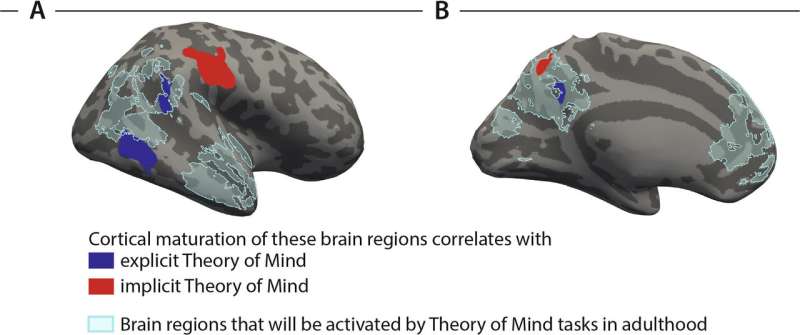The brain has two systems for thinking about the thoughts of others

In order to understand what another person thinks and how he or she will behave, people must adopt someone else's perspective. This ability is referred to as "theory of mind." Until recently, researchers were at odds concerning the age at which children are able to do such perspective-taking. Scientists at the Max Planck Institute for Human Cognitive and Brain Sciences (MPI CBS), University College London, and the Social Neuroscience Lab Berlin shed new light on this question in a study now published in the Proceedings of the National Academy of Sciences.
According to the study, four-year-olds seem to be able to understand what others think. The study reports that this unique ability emerges around four years of age because of the maturation of a specific brain network that enables this. Younger children are capable of predicting others' behavior based on what they think, but the study shows that this prediction of behavior relies on a different brain network. The brain seems to have two separate systems to take another person's perspective, and these mature at different rates.
The researchers investigated these relations in a sample of three- to four-year-old children with the help of a video clips that show a cat chasing a mouse. The cat watches the mouse hiding in one of two boxes. While the cat is away, the mouse sneaks over to the other box, unnoticed by the cat. Thus, when the cat returns, it should still believe that the mouse is in the first location.
Using eye-tracking technology, the scientists analyzed the looking behavior of the study participants. Both, the three- and four-year-olds expected the cat to go to the box where the mouse had originally been. That is, they predicted correctly where the cat was going to search for the mouse based on the cat's belief.
Interestingly, when the scientists asked the children directly where the cat will search for the mouse, three-year-olds answered incorrectly. Only four-year-olds succeeded. Control conditions ensured that this was not because the younger children misunderstood the question.
The study shows that different brain structures were involved in verbal reasoning about what the cat thinks as opposed to non-verbal predictions of how the cat is going to act. The researchers refer to these brain structures as regions for implicit and explicit theory of mind. These cortical brain regions mature at different ages to fulfill their function. The supramarginal gyrus that supports non-verbal action prediction matures earlier, and is also involved in visual and emotional perspective-taking. "This enables younger children to predict how people will act. The temporoparietal junction and precuneus through which we understand what others think—and not just what they feel and see, or how they will act—only develops to fulfill this function at the age of four years," says first author Charlotte Grosse Wiesmann from the MPI CBS.
"In the first three years of life, children don't seem to fully understand yet what others think," says co-author Nikolaus Steinbeis from the University College London. "But there already seems to be a mechanism a basic form of perspective taking, by which very young children simply adopt the other's view."
More information: Two systems for thinking about others' thoughts in the developing brain, PNAS (2020). DOI: 10.1073/pnas.1916725117




















